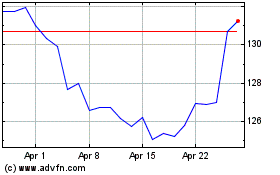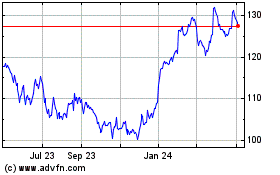Prescription-drug Shortages Help Push Up Prices of Similar Drugs
April 12 2017 - 5:29PM
Dow Jones News
By Peter Loftus
Prescription-drug supply shortages have hurt U.S. medical care
in recent years. According to new research, they've also caused
another side effect -- drug-price increases.
A shortage of the bladder-cancer drug BCG in 2014 and 2015 led
to sharp price increases for a less effective alternative
treatment, mitomycin, according to research published online
Wednesday by the New England Journal of Medicine.
The average wholesale price of a vial of mitomycin, a generic
drug, nearly doubled to $869.59 in August 2014, shortly after the
BCG shortage developed. The cost of a lower-dose vial of mitomycin
rose 146% to $165.60.
The manufacturer of generic mitomycin, Accord Healthcare Inc.,
didn't respond to emails and a phone call seeking comment.
As the BCG shortage continued due to manufacturing snafus at
drugmakers Sanofi SA and Merck & Co., prices for mitomycin
increased again in 2015, to $1,415 for the higher-dose vial and
$272.46 for the lower dose, according to the research, which cites
data from Truven Health Analytics. The increases contributed to
higher spending on mitomycin by the federal Medicare
health-insurance program for the elderly, rising to $15.8 million
in 2015 from $4.3 million in 2012, according to the NEJM
research.
"There's a secondary shock" of shortages, said one of the NEJM
article's co-authors, Benjamin Davies, a urology professor at
University of Pittsburgh School of Medicine, in an interview. "Not
only can we not give you the drug we want to give you, but the drug
we don't want to give you is now more expensive than it was last
month."
Dr. Davies, who co-wrote the NEJM article with researchers from
Harvard Medical School, said he and other urologists had "noticed
immediately" the price of mitomycin jumped after the BCG shortage
developed. "We assumed it was price gouging," he said.
High and rising drug prices have sparked criticism of the
pharmaceutical industry in recent years. President Donald Trump has
called prices excessive and vowed to take steps to bring them
down.
Other drug-supply disruptions have led to price increases. In
2011, Teva Pharmaceutical Industries Ltd. ceased production of an
anti-parasitic agent, mebendazole. The price of an alternative
treatment, albendazole, soared to $119.58 in 2013 for a typical
daily dose from $5.92 in 2010, according to a 2014 NEJM article.
Amedra Pharmaceuticals hiked the price after buying the marketing
rights to the drug from GlaxoSmithKline PLC. Amedra is now part of
Impax Laboratories Inc.; an Impax spokesman said the drug's price
was already established when Impax acquired it, and the company
doesn't disclose product pricing.
The authors of the new NEJM paper say more should be done to
prevent drug shortages, which are often caused by outdated
manufacturing facilities. They proposed additional U.S. regulatory
incentives for companies to maintain high-quality production
capacity, and easing limits on the importation of drugs made
outside the U.S.
The number of drugs in shortage in the U.S. peaked in 2014 at
around 320 and has since declined, but there are still about 176
active shortages, according to the University of Utah Drug
Information Service. Many shortages developed because companies
failed to build enough production capacity, haven't maintained
equipment, and failed to ward off contamination in aging
plants.
Factory contamination caused shortages of BCG, which forced
doctors to delay treatment, cut dosing or switch patients to
alternative treatment. Merck is now the sole supplier of BCG for
the U.S. after Sanofi said in November it would cease production of
its version.
A federal law passed in 2012 gave the U.S. Food and Drug
Administration more powers to prevent and resolve shortages,
including requiring manufacturers to provide advance notice to the
agency of potential shortages, and allowing the FDA to speed up
approvals of manufacturing upgrades.
Write to Peter Loftus at peter.loftus@wsj.com
(END) Dow Jones Newswires
April 12, 2017 17:14 ET (21:14 GMT)
Copyright (c) 2017 Dow Jones & Company, Inc.
Merck (NYSE:MRK)
Historical Stock Chart
From Aug 2024 to Sep 2024

Merck (NYSE:MRK)
Historical Stock Chart
From Sep 2023 to Sep 2024
